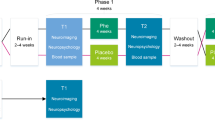Abstract
Patients with phenylketonuria (PKU) may suffer from cognitive and neurological deficits which are related to reduced intracerebral concentrations of catecholamines. The function of phenylalanine (Phe) as an inhibitor of the uptake of the precursor amino acid tyrosine (Tyr) through the blood-brain barrier as well as an inhibitor of the expression of dopamine receptors in the brain is under investigation. Positron emission tomography (PET) is a method for quantitatively determining biochemical and physiological processes in vivo. In the current pilot study, l-[1-11C]-Tyr and 18F-fluoro-ethyl-spiperone (FESP) have been used. The metabolic pathway of carboxylic labelled Tyr is mainly incorporation into protein. From the measured tissue and plasma activity as a function of time in combination with a compartimentai model the Protein Synthesis Rate (PSR) for Tyr can be calculated. FESP is a ligand which binds irreversibly to the dopamine D2-receptor and has also a low non specific binding, although affinity to the serotonin receptor has been described. The ratio of FESP concentration in striatum and in cerebellum is a measure of the receptor status in vivo. In patients with plasma Phe levels above the maximum therapeutic concentration (>700 µmol/1) the PSR for Tyr was decreased as compared to controls and patients with plasma Phe concentrations within the therapeutic range, indicating a decreased availability of Tyr for neurotransmitter synthesis, and hence explaining the reduced cerebral concentration of catecholamines.
Similar content being viewed by others
Abbreviations
- FESP :
-
18F-fluoroethyl-spiperone
- PET :
-
positron emission tomography
- Phe :
-
phenylalanine
- PKU :
-
phenylketonuria
- PSR :
-
protein synthesis rate
- Tyr :
-
tyrosine
References
Bick U, Fahrendorf G, Ludolph AC, Vassallo P, Weglage J, Ullrich K (1990) Disturbed myelination in patients with treated hyperphenylalaninemia: evaluation with magnetic resonance imaging. Eur J Pediatr 150: 185
Choi TB, Partridge WM (1986) Phenylalanine transport of the human blood-brain barrier. J Biol Chem 261: 6536
Hommes FA (1993) The effect of hylerphenylalaninaemia on the muscarinic acetylcholin receptor in HPH-5 mouse brain. J Inherited Metab Dis 16: 962–974
Korinthenberg R, Ullrich K, Fiillen-kemper F (1988) Evoked potentials and electroencephalography in adolescents with phenylketonuria. Neuropediatrics 19: 175–178
Ludolph A, Ullrich K, Nedjat S, Masur H, Bick U (1992) Neurological outcome in 22 treated adolescent patients with hyperphenylalaninemia. A clinical and electrophysiological study. Acta Scand Neurol 85: 243–248
Naumann ML, Kemper TL (1982) Morphologic and histoanatomic observations of the brain in untreated human phenylketonuria. Acta Neuropathol 58: 55
Okano Y, Eisensmith RC, Güttler F (1991) Molecular basis of phenotypic heterogeneity on phenylketonuria. New Engl J Med 324: 1232–1238
Paans AMJ, Willemsen ATM (1993) Annual Report PET-Center AZG/RUG. p3
Paans AMJ, Vaalburg W (1987) Metabolic imaging: PET or NMR? In: Wall EE van der (ed) Non-invasive imaging of cardiac metabolism. Martinus Nijhoff, Dordrecht, pp 297–308
Paans AMJ, Tilkema SP, Pruim J, Visser GM, Eisinga PH, van Waarde A, Studeny M and Vaalburg W (1991) Performance parameters of the Siemens ECAT 951 positron camera with its new computer configuration. Eur J Nucí Med 18: 603
Paans AMJ, Eisinga PH, Vaalburg W (1993) Carbon-11 labeled tyrosine as a probe for modeling the protein synthesis rate. In: Mazoyer BM, Heiss WD, Cornar D (eds) PET studies on amino acid metabolism and protein synthesis. Kluwer Academic, Dordrecht/Boston/London, pp 161–174
Patlak CS, Blasberg RG (1985) Graphical evaluation of blood-to-brain transfer constants from multiple-time uptake data, generalizations. J Cereb Blood Flow Metab 5: 584–590
Peterson NA, Shah SN, Rhagupathy E, Riioads R (1983) Presynaptic tyrosine availability in the Phenylketonurie brain: a hypothetical explanation. Brain Res 272: 189–193
Report of Medical Research Council Working Party on Phenylketonuria (1993) Recommendations on the dietary management of phenylketonuria. Arch Dis Child 68: 426–427
Scriver MR (1991) Phenylketonuria, genotypes and phenotypes. N Engl J Med 324: 1280–1281
Scriver MR, Kaufmann S, Woo SLC (1989) The hyperphenylalaninemias. In: The metabolic basis of inherited disease, 6 edn. McGraw Hill Company, New York, pp 495–546
Talairach J, Tournoux P (1988) Copla-nar stereotaxic atlas of the human brain. Thieme, New York
Thompson AJ, Smith I, Brenton D, Youe BD, Rylance G, Davidson DC, Endall B, Jees AJ (1990) Neurological deterioration in young adults with phenylketonuria, Lancet 190; 336: 602
Vaalburg W, Paans AMJ, (1983) Shortlived positron emitting radionuclides. In: Helus F (ed) Radionuclides production II, CRC Pres, Boca Raton (Fl) pp 47–101
Wendel U, Ullrich K (1990) Six year follow-up of phenylalanine intakes and plasma phenylalanine concentrations. Eur J Pediatr [Suppl] 1: 13
Wienhard K (1991) Modélisation: application to the D2 receptor, In: Baron JC, Cornar D, Farde L, Martinot JL, Mazoyer B (eds) Brain dopaminergic systems: imaging with positron emission tomography. Kluwer Academic, Dordrecht, pp 85–95
Wienhard K, Coenen HH, Pawlik G, Heboid I, Jovkar S, Stöcklin G, Heiss WD (1989) PET investigation of the dopaminergic system in neurological patients using 3-N-[18F] fluoroefhyl-spiperone. In: Beckers C, Goffinet A and Bol A (eds) Positron emission tomography in clinical research and clinical diagnosis. Kluwer Academic, Dordrecht, pp 90–107
Willemsen ATM, Waarde A van, Paans AMJ, Pruim J, Luurtsema G, Go KG, Vaalburg W (1995) In vivo protein synthesis rate determination with l-[1-″C]-tyrosine and positron emission tomography: methods, metabolism, modeling and results in patients with primary or recurrent brain tumors. J Nucl Med 35: 411–419
Author information
Authors and Affiliations
Rights and permissions
About this article
Cite this article
Paans, A.M.J., Pruim, J., Willemsen, A.T.M. et al. Neurotransmitter positron emission tomographic-studies in adults with phenylketonuria, a pilot study. Eur J Pediatr 155 (Suppl 1), S78–S81 (1996). https://doi.org/10.1007/PL00014257
Issue Date:
DOI: https://doi.org/10.1007/PL00014257




